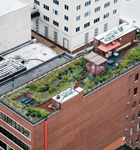At a Glance
Location
Grand Forks, ND
Founded
1993
Specialty
Senior-living facilities
You first got involved with Edgewood in the early 1990s. How has the company grown since then?
Phil Gisi: We’re currently one of the largest assisted-living providers in the Midwest, something we’ve achieved by staying mostly in smaller communities with populations of less than 50,000. Only nine of our facilities are in communities larger than 50,000 people. That was a conscious decision we made in 1996 … because a lot of the larger publicly traded firms focused on larger markets. We’re still privately owned.
Demographics are a big factor in your feasibility studies. What are some of the most important demographics to be looking at right now?

PG: The demographics in this industry are interesting. Right now, our primary market is 75–85 year olds, our average resident is about 83 years old, and today’s oldest Baby Boomers are turning 65. Demographics will drive our business, and I’m always trying to think five to 10 years down the road to best position my company in the long term.
Senior housing is a rapidly growing industry. How is Edgewood keeping up and planning for the future?
PG: Even though a lot of people in real estate are suggesting that senior housing is a good investment right now, the demand hasn’t even hit us yet. People who were born between about 1930 and 1935 are now 75 to 80 years old. But there actually weren’t a lot of births during the Great Depression, so the elderly population that we’re serving today is based on a birth rate that was extremely low. The Baby Boomers won’t even start to need assisted-living services for at least another five to eight years. Over the next 25 years, the 65-and-up population will almost double, but the general population will only go up by about 20 or 25 percent.
What sets you apart from the competition?
PG: Although there will always be a market for upscale facilities, I really think that seniors and their adult children will want a good value. I’ve found that many seniors are concerned about their Baby Boomer children, who generally haven’t saved enough for retirement, and they want to make sure that there’s enough money to provide for their families. So while we offer amenities like small movie theaters, fitness centers, and coffee houses, ultimately we offer a great value.
Our one-bedroom apartments are usually about 560 square feet and have bay windows. We carefully allocate funds every year for upgrades and replacements to fixtures and furniture. All of our assisted-living facilities have dedicated chapels, something not every senior-living facility has. Our chapels look and function like typical chapels—they’re not used for any other purpose.
Dementia and Alzheimer’s are becoming more common. How does Edgewood account for this?
PG: Memory care is an important feature in our facilities. We have dedicated units within all of our assisted-living facilities plus a number of stand-alone memory facilities where we just treat people with conditions like Alzheimer’s and dementia. Out of our 2,300 beds, about 700 units are dedicated to memory care. They require small, home-like living spaces and more staff. Most of our memory-care facilities have only 12 to 20 beds.

As the Baby Boomers begin to move into assisted-living facilities, the increased demand will put a lot of pressure on the existing facilities. It’s hard to tell what inflation and housing prices will look like over the next five to eight years, but by locking in today’s extremely low-interest rates, providing excellent service and care, and keeping our facilities in good shape, I am betting that my facilities will be able to aggressively compete with buildings that will cost a lot more to build in the future. ABQ


